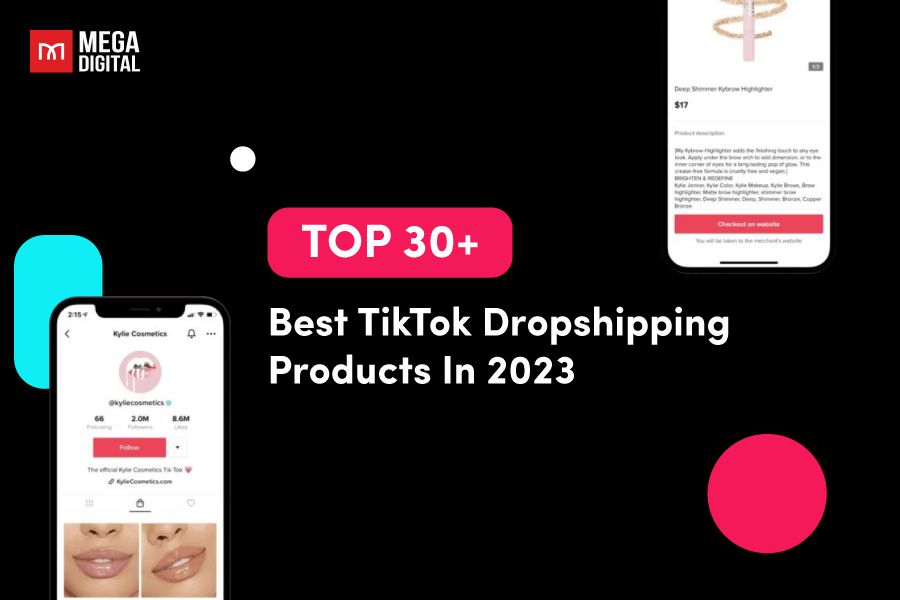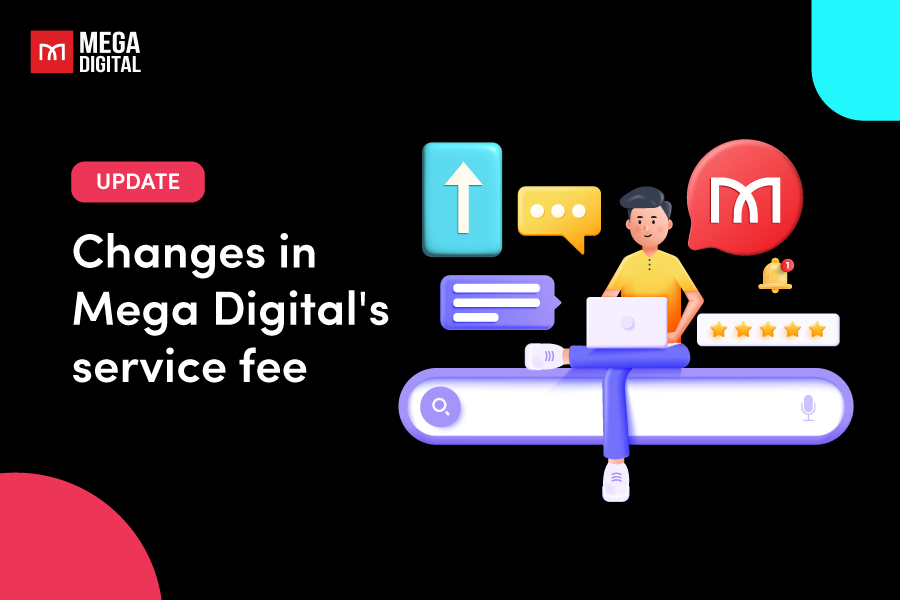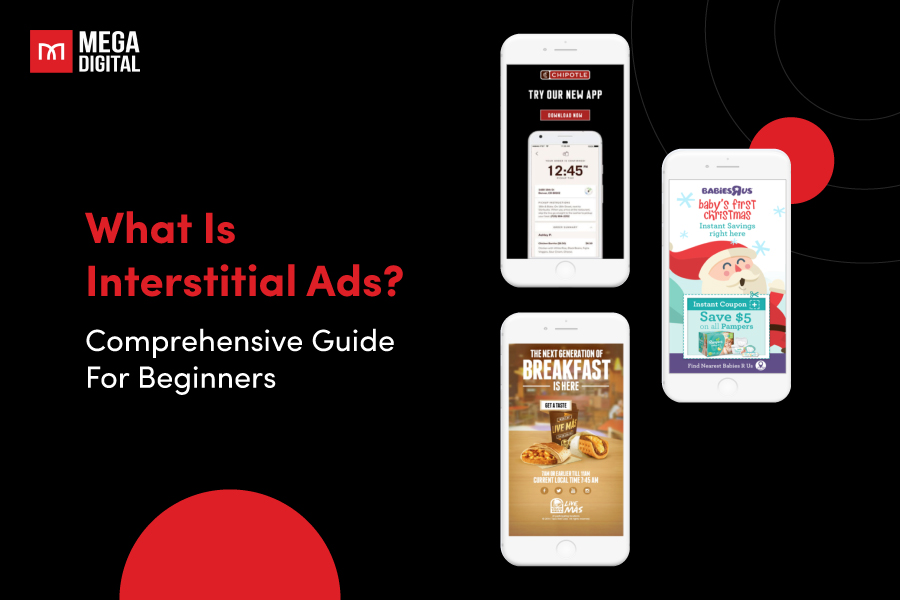Did you know that over 2.9 billion people use Facebook every month? That’s a massive potential customer base for your business, but it also means fierce competition for attention. The key to success is to optimize Facebook Ads that resonate with your target audience and drive real results. In this guide, I’ll unveil the secrets to optimizing your Facebook Ads, helping you transform them from money pits to conversion machines.
- Why should you optimize Facebook Ads?
- 6 Signs that You Should Optimize Facebook Ads
- Facebook Ads Optimization Checklist
- 15 Strategies to Optimize Facebook Ads
- #1. Build Facebook Ads Funnel
- #2. Consult Facebook Experts
- #3. Reach the right target audiences
- #4. Target audiences by device
- #5. Repurpose existing content
- #6. Create compelling Facebook ads and dynamic creative
- #7. Use Video Content
- #8. Use Facebook Ads Library
- #9. Leverage Automatic Placements
- #10. Optimize budget and bidding strategy
- #11. Install Facebook Pixel
- #12. Optimize landing page
- #13. Choose the right optimization event
- #14. Consider the Learning Phase of your advertisements
- #15. Include a CTA
- #16. A/B Testing
Why should you optimize Facebook Ads?
Optimizing Facebook Ads is essential for several reasons. Here are some key reasons why you should optimize your Facebook Ads:
- Cost Efficiency: Optimization helps you reduce your advertising costs by improving the performance of your ads. By identifying and targeting the right audience, optimizing ad placements, and refining your ad creative, you can increase your ad relevancy and engagement, resulting in a lower cost per click (CPC) or cost per acquisition (CPA).
- Increased Reach and Engagement: Facebook Ads optimization allows you to maximize the reach and engagement of your ads. By testing different ad formats, targeting options, and placements, you can identify the strategies that resonate best with your target audience. This helps you deliver more compelling ads that generate higher click-through rates (CTR), likes, comments, and shares, thereby increasing your overall reach and engagement.
- Improved Ad Relevance and Quality Score: Facebook rewards advertisers who deliver highly relevant and engaging ads by assigning higher quality scores. A higher quality score positively impacts your ad’s visibility and lowers your advertising costs. By optimizing your ads, you can align your messaging, targeting, and creative elements with the interests and preferences of your audience, leading to improved ad relevance and a better quality score.
- Enhanced Conversion Rates: Optimization enables you to refine your ad strategy to better align with your conversion goals. By analyzing data, conducting A/B tests, and tracking key performance metrics, you can identify which ad variations, targeting options, and landing page experiences result in the highest conversion rates. This data-driven approach helps you optimize your campaigns to drive more conversions, whether it’s sales, sign-ups, or other desired actions.
- Adapting to Changing Market Conditions: Optimization allows you to respond and adapt to changing market conditions, consumer behavior, and competitive landscapes. By continuously monitoring your campaign performance and making data-informed optimizations, you can stay ahead of the curve. This agility helps you make timely adjustments to your targeting, messaging, and creative strategies, ensuring your ads remain effective and relevant over time.
In summary, optimizing your Facebook Ads enables you to improve cost efficiency, increase reach and engagement, enhance ad relevance, boost conversion rates, and adapt to evolving market dynamics. By investing time and effort into optimization, you can maximize the effectiveness and return on investment (ROI) of your Facebook advertising campaigns.
6 Signs that You Should Optimize Facebook Ads
Optimizing Facebook ads is an ongoing process that requires monitoring and analysis to determine when adjustments are necessary. Here are some key indicators to help you know when to optimize your Facebook ads:
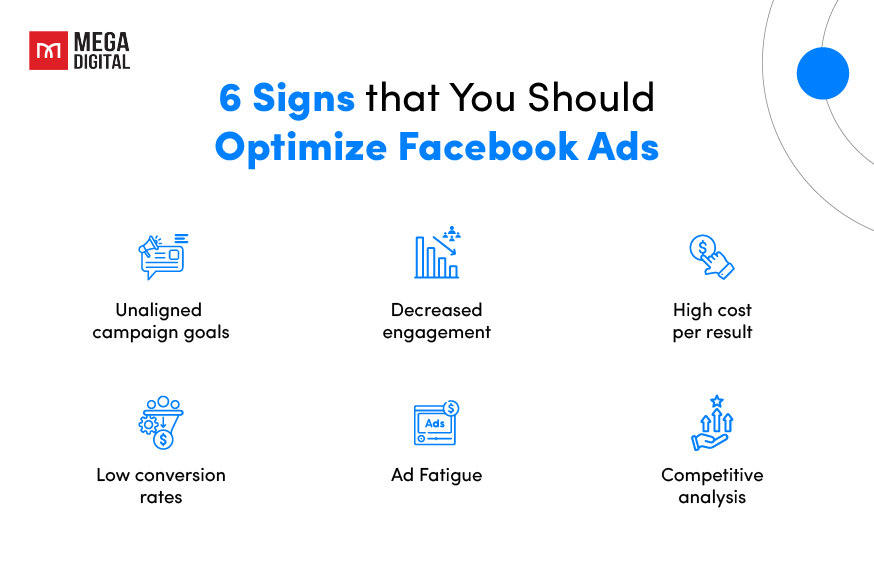
- Unaligned campaign goals: Evaluate your campaign goals and objectives. If you’re not achieving the desired results or if your campaign is not aligned with your business objectives, it’s a sign that optimization is needed.
- Decreased engagement: If you notice a significant drop in engagement metrics such as likes, comments, and shares on your Facebook ads, it may indicate that your advertising is not resonating with your target audience. This could be a sign that you need to optimize your ad content, targeting, or both.
- High cost per result: If you’re experiencing a high cost per result, such as cost per click (CPC) or cost per acquisition (CPA), it suggests that your ads are not performing efficiently. Optimizing your Facebook advertising involves improving your ad targeting, creative elements, and bidding strategy to achieve better results at a lower cost.
- Low conversion rates: If you’re driving traffic to your website or landing page through Facebook ads but experiencing low conversion rates, it’s a clear indication that your advertising needs optimization. You may need to reassess your ad copy, landing page design, user experience, or targeting to improve conversion rates and maximize the return on your ad spend.
- Ad Fatigue: Facebook Ad fatigue occurs when your target audience becomes less responsive to your ads over time. If you notice a decline in performance or engagement metrics, it may be a sign that your ads are becoming stale. Consider refreshing your ad creative, changing the copy, or trying different ad formats
- Competitive analysis: Keep an eye on your competitors’ activities and ad strategies. If you notice that your competitors are consistently outperforming you or if they have made significant changes to their ad campaigns, it may be time to optimize your own ads to stay competitive.
Remember, optimization is an iterative process, and it’s important to track the impact of the changes you make. Continuously monitor, analyze, and adjust your Facebook ads to maximize their effectiveness and achieve your marketing goals.
Facebook Ads Optimization Checklist
This checklist will guide you through key areas to focus on when checking and optimizing your Facebook Ads:
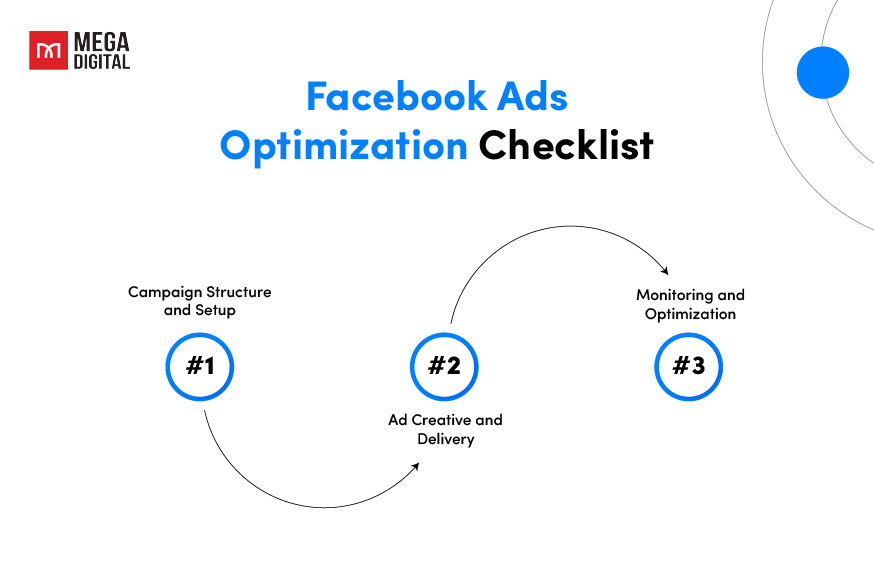
#1. Campaign Structure and Setup
- Campaign Objective: Align your objective with your goals (Brand awareness, website traffic, conversions, etc.).
- Budget and Bidding Strategy: Set a realistic budget and choose a bidding strategy that fits your objective (automatic bidding for conversions, manual bidding for more control).
- Ad Set Targeting: Ensure your Facebook Ad target right audience who is well-defined using demographics, interests, behaviors, and Lookalike Audiences.
- Conversion Tracking: Make sure the Meta Pixel is installed correctly to track conversions on your website or landing page.
#2. Ad Creative and Delivery
- Ad Formats: Test different Facebook ad types (images, videos ads, carousels ads) to see what resonates best with your audience.
- Ad Copy: Craft compelling ad copy that speaks directly to your target audience’s needs and desires. Use clear headlines, descriptions, and strong calls to action (CTAs).
- Creatives: Use high-quality visuals that are relevant to your ad copy and target audience.
#3. Monitoring and Optimization
- Campaign Performance: Regularly review key metrics like impressions, reach, clicks, conversions, and cost-per-acquisition (CPA).
- A/B Testing: Test different variations of your ad creatives, targeting options, and landing pages to see what performs best.
- Relevance Score: Monitor your ad relevance score and make adjustments to improve the alignment between your ads and target audience.
15 Strategies to Optimize Facebook Ads
#1. Build Facebook Ads Funnel
Running Facebook ads is a great way to reach new customers, but simply throwing up a campaign and hoping for the best won’t get you the results you desire. To maximize your return on investment (ROI), you need a strategic approach – enter the Facebook ads funnel.
What is a Facebook Ads Funnel?
Think of a funnel as a multi-stage journey that takes potential customers from unaware of your brand to loyal buyers. Here’s how it breaks down:
- Awareness (Top of Funnel – TOFU): Introduce your business to a broad audience. Use Brand Awareness or Reach campaigns to build recognition and spark interest.
- Consideration (Middle of Funnel – MOFU): Now that they know you exist, nurture their interest. Engagement, Traffic, Video Views, Lead Generation, and App install objectives help you connect with potential customers and provide valuable content.
- Conversion (Bottom of Funnel – BOFU): This is where the magic happens! Leverage Conversion, Catalog Sales, or Store Traffic objectives to drive sales or store visits. Make it easy for them to take action with a clear CTA (call to action).
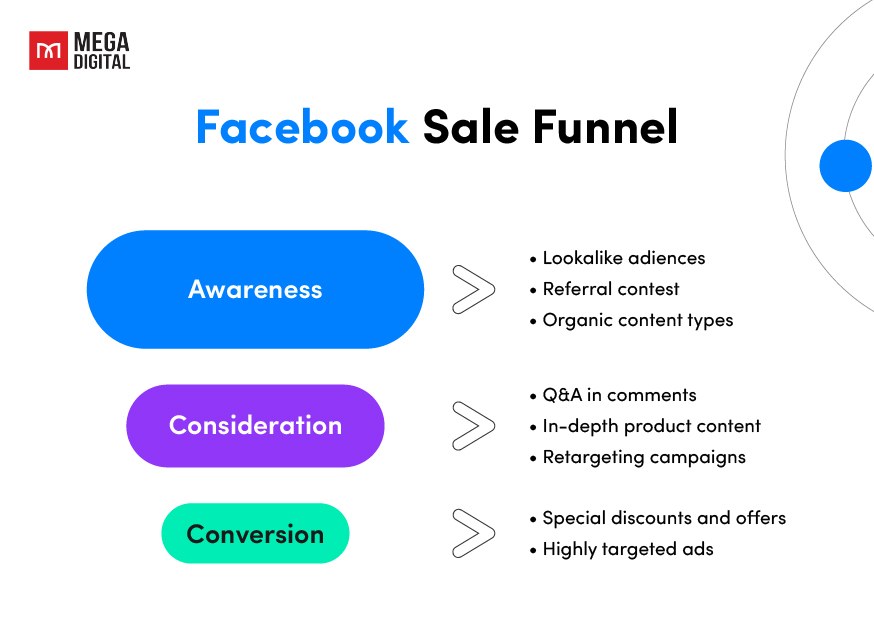
Furthermore, implementing a Facebook ad funnel also helps manage costs effectively. Lower-funnel campaigns aimed at sales and conversions can be costly. Without warming up your audience through earlier campaigns, you risk spending a significant amount without seeing results.
On the other hand, upper-funnel campaigns focused on reach and awareness are more budget-friendly. Starting with these campaigns enables you to engage with your target audience and generate interest before transitioning to more expensive revenue-driven campaigns. This strategy saves money while optimizing outcomes.
#2. Consult Facebook Experts
Optimizing Facebook Ads campaigns requires expertise, time, and a data-driven approach. While managing campaigns in-house can be rewarding, partnering with a Facebook Ads agency offers distinct advantages that can propel your optimization efforts to new heights. Especially, when you collaborate with Mega Digital, you will have some benefits below:
- Expertise: Mega Digital boasts a team of experienced professionals with in-depth knowledge of Facebook advertising strategies, best practices, and industry trends. Partnering with us means tapping into a wealth of expertise to optimize campaigns for maximum effectiveness.
- Customized Strategies: We understand that every business is unique, which is why we tailor our Facebook ad strategies to align with each client’s specific goals, target audience, and budget. Our customized approach ensures that campaigns are designed to deliver optimal results for our clients.
- Full-Service Solutions: From campaign planning and ad creation to performance monitoring and optimization, Mega Digital offers comprehensive, end-to-end solutions for Facebook advertising. Especially, I provides you Facebook Ads Agency Account that not only can you access more specialized advertising features, but you also can target worldwide audiences. To see more details, here:
- Proven Track Record: With a track record of success in running Facebook ad campaigns for clients across various industries, Mega Digital has demonstrated its ability to deliver tangible results. Clients can trust us to drive meaningful outcomes and achieve their advertising objectives.
- Ongoing Support: Our partnership with clients doesn’t end once the ad campaign is launched. We provide ongoing support, guidance, and optimization to ensure that campaigns continue to perform at their best and deliver long-term value for our clients.
#3. Reach the right target audiences
Facebook Audience Insights provides insights into your current audience and potential target demographics. Here are some examples of the data you can gather using Facebook’s Audience Insights:
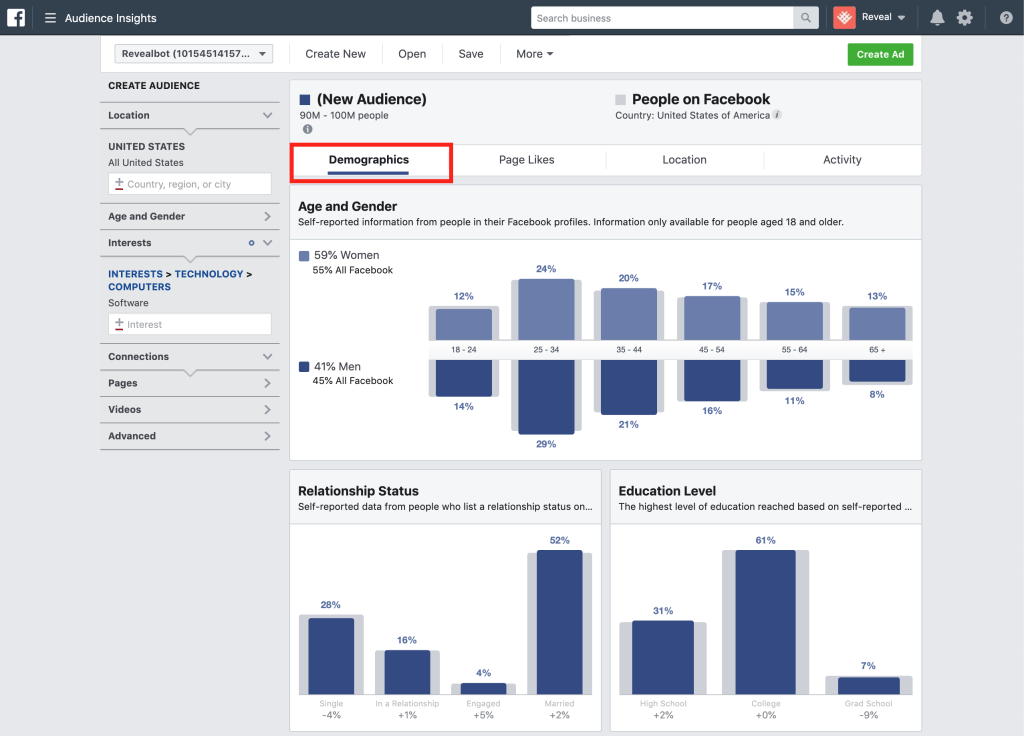
- Demographics: Audience Insights gives you information about the demographic characteristics of your current audience and potential target audience. This includes age, gender, relationship status, education level, job title, and more. Understanding these demographics can help you tailor your ads and content to better resonate with your audience.
- Interests: This feature provides insights into the interests and hobbies of your target audience. It shows what pages they like, the activities they engage in, and the topics they are interested in. This data can help you create relevant and engaging content that aligns with your interests.
- Location: Audience Insights allows you to understand the geographic location of your audience. You can see their country, city, and even the languages they speak. This information is especially useful if your business operates in specific regions or if you want to target users in certain locations.
- Behaviors: Facebook provides data on user behaviors, such as their purchasing behavior, device usage, and online activities. This information helps you understand the habits and preferences of your audience, allowing you to tailor your ads and offers accordingly.
- Facebook Usage: You can gain insights into how frequently your audience uses Facebook, the devices they use, and their engagement patterns. This data can help you determine the best times to run your ads and the types of content that are most likely to resonate with them.
- Connections: Audience Insights provides information about the connections your audience has on Facebook. You can see if they are connected to your page, if they are part of any specific groups, or if they have liked any related pages. This information can help you identify potential partnerships, influencers, or collaborations to expand your reach.
By analyzing the data provided by Facebook’s Audience Insights, you can develop a deeper understanding of your target audience, create more personalized content, and refine your targeting strategies to maximize the return on ad spend (ROAS).
#4. Target audiences by device
Targeting your Facebook ads by device can be a valuable strategy to reach your audience more effectively. Here are some options for targeting your ads by device:
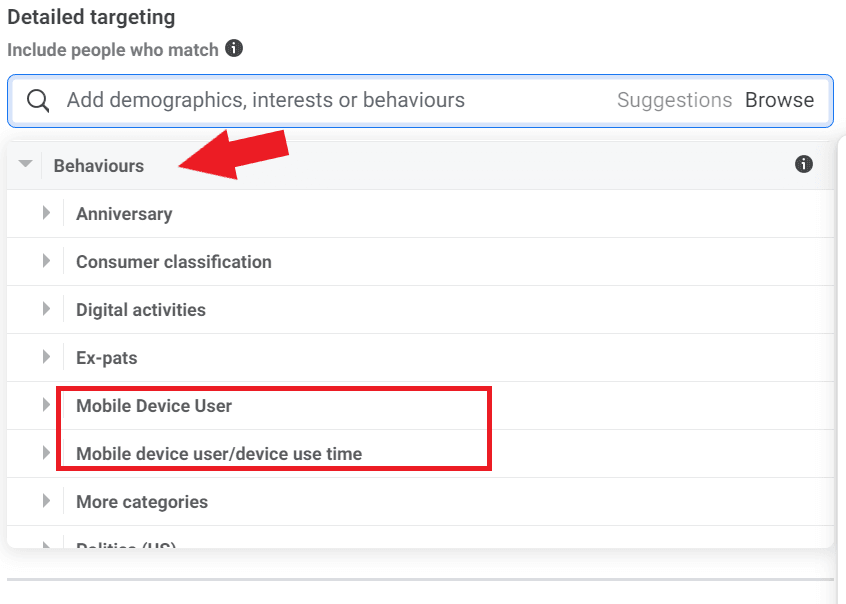
- Target devices by location: When setting up your ad group, you can choose which devices you want your ad to be shown on. This includes options such as device type (mobile, desktop, tablet), operating system (iOS, Android, Windows), brand, and even specific device models. This level of granularity allows you to tailor your ads to specific devices that your target audience is using.
- Exclude certain devices: In addition to selecting specific devices to target, you can also exclude certain devices from seeing your ads. This can be useful if you have identified that certain devices are not performing well or if you want to focus your budget on specific device types.
- Behavioral targeting: Behavioral targeting allows you to target users based on their device ownership regardless of the device they are currently using. This is particularly helpful if your audience tends to own multiple devices. For example, you can target users who own iPhones, even if they are currently viewing your ad on a different device.
By targeting your Facebook ads by device, you can refine your audience and tailor your ad content to specific devices. This level of customization can help you create a more personalized and impactful ad experience for your audience. Additionally, understanding the devices your audience uses can inform your ad creative and optimization strategies, ensuring that your ads are optimized for the specific devices your audience prefers.
Remember to regularly monitor the performance of your device-targeted ads and make adjustments as needed. Analyze the data and insights provided by Facebook’s ad reporting to optimize your targeting and maximize the effectiveness of your campaigns.
#5. Repurpose existing content
To maximize your campaign’s effectiveness, consider repurposing existing content rather than creating new material from scratch. While new content may be necessary in some cases, leveraging proven organic content can save both time and resources. Here’s how you can get more mileage from your existing content:
- Assess the content: Review your organic posts on social media and identify those that have generated significant engagement, such as reactions, shares, or comments. These are indicators that the content has resonated with your audience.
- Choose the right post: Select the post that aligns well with your campaign’s objective and target audience. It should convey the message you want to promote and support your campaign goals.
- Use the “Use Existing Post” option: When creating a new Facebook ad, choose the “Use Existing Post” option. This allows you to repurpose the selected organic post for your ad campaign.
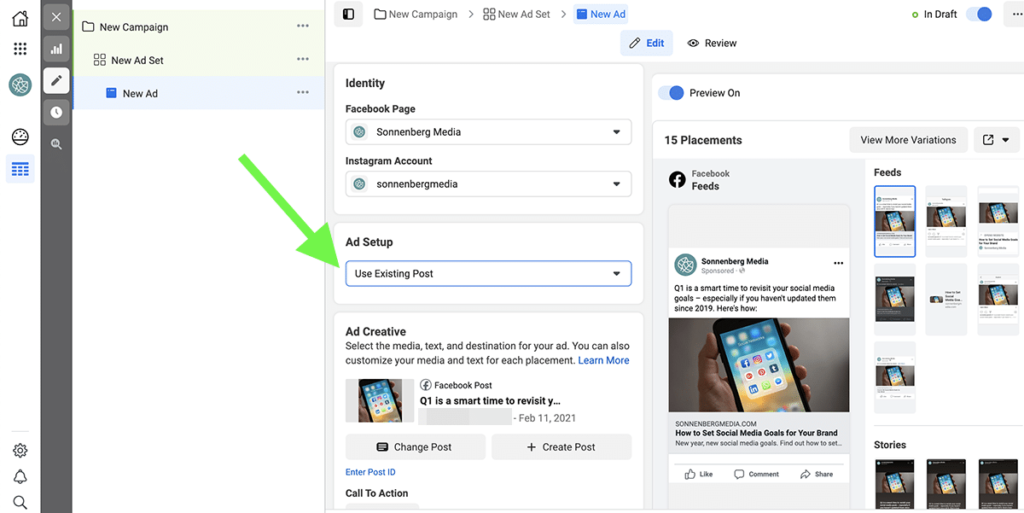
- Leverage social proof: By using a post with existing engagement, you benefit from social proof. The engagement on the post serves as evidence that others trust and engage with your business. This can increase the credibility of your ad and make your target audience more likely to engage with it.
- Monitor and optimize: Keep an eye on the performance of your repurposed content. Monitor key metrics such as reach, engagement, and conversions. If necessary, make adjustments to targeting, bidding, or creative elements to optimize the ad’s performance.
Remember: Repurposing doesn’t mean simply copying and pasting. Consider tailoring the repurposed content to specifically fit the objective of your Facebook Ads campaign.
By strategically repurposing existing, high-performing content, you can fuel your Facebook Ads campaigns and stretch your marketing muscle further, achieving better results without breaking the bank.
#6. Create compelling Facebook ads and dynamic creative
Compelling ad creatives are the cornerstone of successful Facebook Ads campaigns. The key lies in understanding your target audience and aligning your message with their needs and preferences.
With over 70% of users accessing content on mobile devices, prioritize a mobile-first approach. Design ads specifically for smaller screens, incorporating responsive design principles for optimal viewing across platforms.
Consider leveraging dynamic creatives powered by your Facebook pixel or SDK. These ads target individuals who have shown interest in your business, ensuring engagement with a primed audience. Maintaining visual consistency across campaigns is essential for brand memorability.
By continuously optimizing your ad creatives and experimenting with different formats, you can effectively connect with your audience and drive engagement. Here are various creative options to explore:
- Product Showcase: Display various products in different settings to highlight their features.
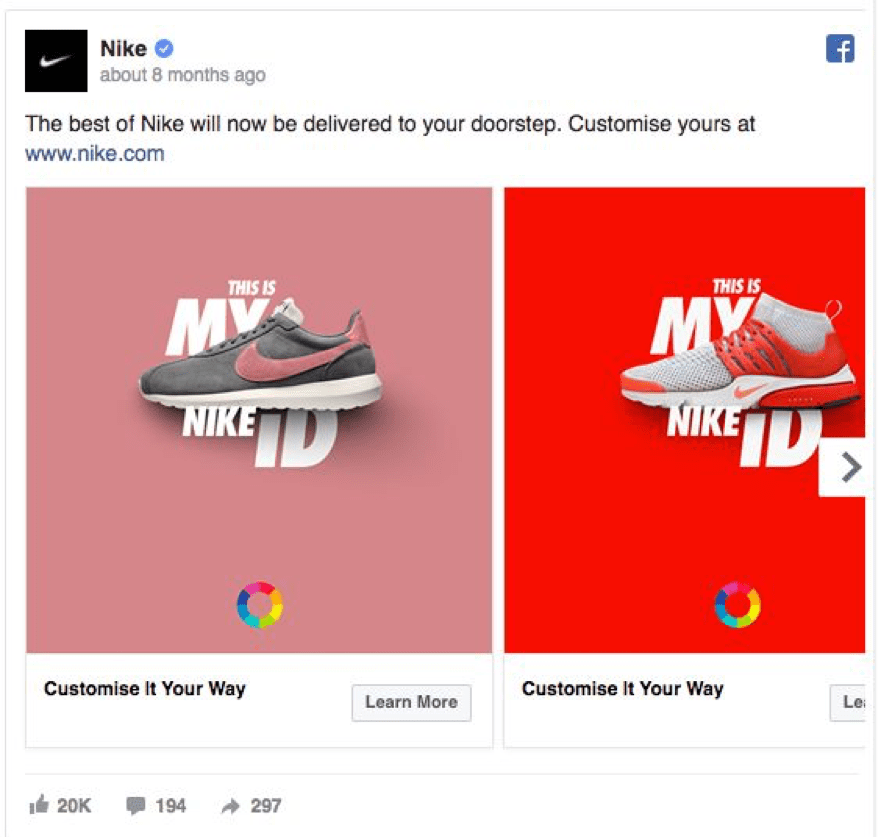
- Service Demonstrations: Create short video clips showcasing different services or products in action.
- Engaging Graphics: Use infographics to illustrate the benefits or features of your offerings.
- Customer Testimonials: Feature reviews or testimonials alongside relevant images to build trust.
- Lifestyle Imagery: Showcase lifestyle images relevant to your brand to evoke emotions and desires.
- Storytelling Videos: Tell stories that resonate with your audience to establish an emotional connection.
- Interactive Content: Incorporate polls, quizzes, or 360-degree product views to engage users actively.
For Facebook Feed Image ads, adhere to the following specifications:
- Recommended image size: At least 1080 x 1080 pixels
- Image file types: JPG or PNG (animated GIFs should be uploaded as video ads)
- Text: Limit to 125 characters
- Headline: Keep it under 27 characters to prevent truncation
- Link description: Also limit to 27 characters
#7. Use Video Content
Using video content in your ad campaigns can have numerous benefits and increase engagement, brand awareness, and conversions. Here are some compelling reasons to incorporate video into your Facebook ads:
- High engagement rates: Videos tend to capture and hold people’s attention better than other forms of content on Facebook. They can convey information in a visually appealing and dynamic way, making them more likely to be watched, liked, shared, and commented on by users.
- Increased brand awareness: Video ads have the potential to reach a larger audience and create a lasting impression. They allow you to showcase your brand’s personality, values, and unique selling propositions in a visually compelling manner. Memorable video content can help increase brand recognition and recall among your target audience.
- Improved conversions: Videos can be highly effective in driving click-through rates and conversions. By incorporating product demonstrations, showcasing key features, and highlighting the benefits of your offerings, videos provide a more immersive and persuasive experience for viewers. They can effectively communicate your value proposition and compel users to take action.
When using video content, consider experimenting with different types of videos to find what works best for your audience. Here are a few types of videos you should consider testing:
- Videos showing customers using the product: Showcase your product or service in action, demonstrating how it solves a problem or enhances the lives of your customers. This type of video provides social proof and allows potential customers to visualize themselves using your offering.
- Customer reviews and user-generated content: Incorporate videos featuring satisfied customers sharing their positive experiences with your brand. User-generated content adds authenticity and credibility to your ads, helping to build trust and encourage conversions.
- Influencer videos: Collaborate with relevant influencers in your industry to create videos endorsing your product or service. Influencers can provide social proof and reach their followers with authentic recommendations, increasing the likelihood of engagement and conversions.
Remember to optimize your videos for mobile viewing, as a significant portion of Facebook users access the platform through mobile devices. Keep your videos concise, visually appealing, and focused on conveying key messages to maximize their impact.
Regularly monitor the performance of your video ads, paying attention to engagement metrics, view duration, click-through rates, and conversions. Use these insights to refine your video content strategy and tailor future campaigns to resonate better with your audience.
By leveraging the power of video content in your Facebook ads, you can effectively grab attention, create a memorable brand experience, and drive meaningful results for your business.
#8. Use Facebook Ads Library
Staying ahead in the digital advertising landscape requires understanding your competitors’ strategies. Exploring your competitors’ advertising strategies can provide valuable insights and help you refine your own approach. Facebook’s Ad Library is a useful tool for gaining transparency into your competitors’ ads. Here’s how the Facebook Ad Library empowers you:
- Visit the Facebook Ad Library: Access the Facebook Ad Library
- Search for ads: Use keywords or the advertiser’s name to search for specific ads. Enter the name of your direct competitor to see the ads they have been running.
- Analyze ad duration: Pay attention to the duration for which your competitor has been running certain ads. If an ad has been running for a significant period, it suggests that the campaign is likely generating a high return on investment. This indicates that the ad is resonating with the target audience and driving desired outcomes.
- Study ad creatives and messaging: Take a closer look at the ad creatives and messaging used by your competitors. Analyze the visual elements, copy, and overall approach they are taking. Consider how you can differentiate your own ads while learning from successful strategies employed by your competitors.
- Identify trends and patterns: Look for recurring themes, strategies, or offers in your competitors’ ads. Identify commonalities or patterns that might indicate successful tactics or messaging that resonates with the target audience. Use this information to refine your own campaigns and make them more competitive.
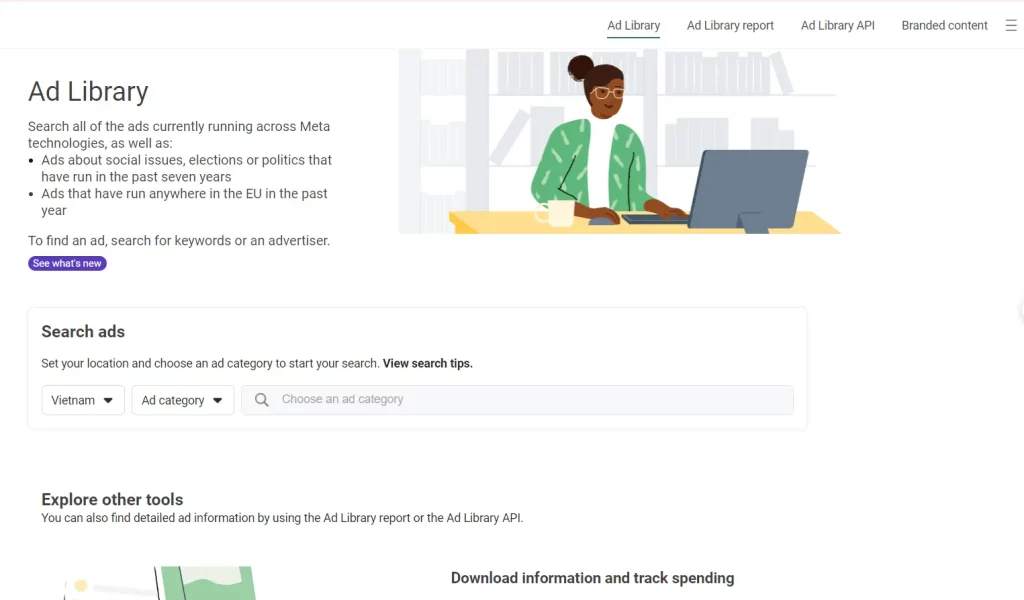
However, it’s important to note that while exploring your competitors’ ads can provide valuable insights, it’s equally important to focus on your unique value proposition and maintain authenticity in your own brand messaging. Use the information you gather as inspiration and guidance to create compelling and differentiated ads that resonate with your own target audience.
Remember to always comply with Facebook’s policies and guidelines when conducting competitive research and avoid copying or infringing on others’ intellectual property.
#9. Leverage Automatic Placements
Where your Facebook Ads appear significantly impacts campaign performance. Facebook offers manual or Facebook Ads placement options. Here are some key points to consider:
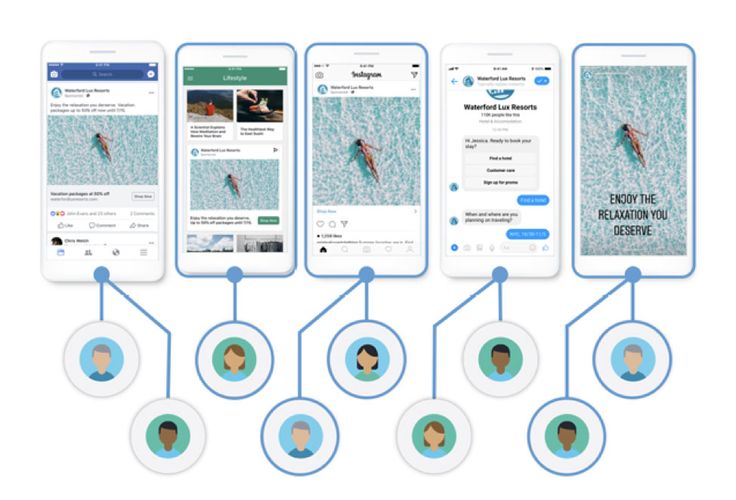
- Definition of locations: In the context of Facebook Ads, “locations” refer to the different places or placements where your ads can be displayed. These can include Facebook’s various ad placements such as the Facebook News Feed, Instagram Feed, Audience Network, and more.
- Manual vs. automatic placements: Facebook Ads provides the option to manually select specific placements for your ads or choose the automatic placements feature. When you opt for automatic placements, Facebook’s algorithm analyzes your ad and determines the best locations to display it based on factors such as audience behavior, performance data, and available inventory.
- Optimization and efficiency: By using automatic placements, you allow Facebook’s algorithm to dynamically optimize your ad delivery across various locations. The algorithm continuously monitors performance and adjusts the placement strategy in real-time. This can help ensure your ad reaches the most relevant audiences and achieves better results.
- Cost-effectiveness: Automatic placements can help reduce costs and make your budget more efficient. The algorithm strives to allocate your budget to the locations where it is more likely to generate the desired outcomes, such as clicks, conversions, or engagement. It takes into account factors like audience preferences, ad performance, and cost per result to optimize your spend.
- Flexibility and adaptability: With automatic placements, your ad can be dynamically reassigned to different locations based on the algorithm’s analysis. This flexibility allows your ad to reach the most receptive audiences and take advantage of emerging opportunities across various platforms and placements.
Note: While automatic placements offer significant advantages, consider manual placements in these scenarios:
- Specific Targeting Needs: If you have a very specific audience you want to reach on a particular platform (e.g., Instagram Stories), manual placements offer more control.
- Campaign Performance Analysis: After running automatic placements for a while, you might gain insights into which placements perform best. You can then leverage manual placements to focus your budget on those high-performing areas.
#10. Optimize budget and bidding strategy
When setting your budget and choosing a Facebook bidding strategy for your Facebook ad campaigns, consider your objectives, target audience, and current ad performance. While Facebook defaults to the lowest-cost bidding strategy, exploring other options can optimize your results. Here are some bidding strategies you can select at the campaign level:
- Lowest Cost (Default): This option prioritizes getting the most conversions or clicks for your budget. It’s a good starting point if you’re new to Facebook advertising.
- Highest Volume: This strategy focuses on maximizing the number of impressions, clicks, or conversions you can achieve within your budget. Ideal for campaigns aiming for broad reach.
- Highest Value: Perfect for campaigns where generating high-value sales or conversions is a priority. Facebook will prioritize showing your ads to users most likely to bring in more revenue.
- Cost Cap: Set a maximum amount you’re willing to pay for each action (e.g., click, conversion). This strategy helps control costs but might limit your reach or conversions.
- Minimum ROAS (Return On Ad Spend): Focuses on maximizing the return you get for your ad spend. Facebook will prioritize conversions that deliver the highest value for your budget.
- Bid Cap: This option allows you to set the maximum amount you’re willing to bid for each ad auction. Offers the most control over bidding but requires a deep understanding of the bidding landscape.
The best bidding strategy isn’t a one-size-fits-all solution. Consider your campaign goals, audience, and budget to make the most informed decision and optimize your Facebook Ads for success.
- Campaign Goals:
- Awareness/Traffic: Use Lowest Cost or Highest Volume for broader reach.
- High-Value Conversions: Choose Highest Value or Minimum ROAS to prioritize valuable actions.
- Specific Cost Control: Opt for Cost Cap for stricter budget limitations.
- Campaign Experience:
- New to Facebook Ads: Start with Lowest Cost to understand how bidding works.
- Comfortable with Bidding: Explore Highest Value, Minimum ROAS, or Bid Cap for more control.
- Budget:
- Limited Budget: Consider Lowest Cost or Cost Cap to maximize results within your constraints.
- Larger Budget: Explore Highest Volume or Highest Value for potentially higher returns.
#11. Install Facebook Pixel
Implementing the Facebook Pixel is a game-changer for your Facebook Ads strategy. The Facebook Pixel is a small piece of code that you place on your website. It collects data about the actions users take on your site and enables you to target specific audiences, track conversions, and optimize your campaigns.
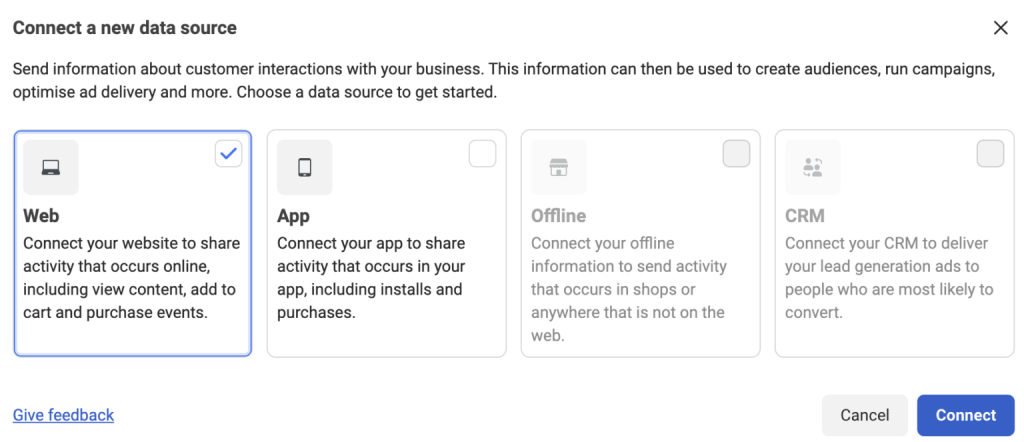
By installing the Facebook Pixel, you can:
- Track conversions: The pixel allows you to measure the actions users take on your website after clicking on your Facebook ads. This includes purchases, sign-ups, form submissions, and more. Tracking conversions helps you understand the effectiveness of your ads and optimize them accordingly.
- Create custom audiences: The pixel collects data about your website visitors, allowing you to create custom audiences based on their behavior. You can retarget these audiences with relevant ads, such as showing ads to people who abandoned their shopping carts or visited specific pages on your site.
- Build lookalike audiences: The pixel enables you to create lookalike audiences based on the characteristics and behaviors of your existing customers. Facebook finds users who resemble your target audience, expanding your reach to potential customers who are likely to be interested in your offerings.
To install the Facebook Pixel, you need to generate the pixel code from your Facebook Ads Manager and add it to the header section of your website. If you’re using a content management system (CMS) or an e-commerce platform, there may be plugins or integration options available to simplify the installation process.
#12. Optimize landing page
Optimizing your landing page is crucial for maximizing the results of your ads and improving conversions. Here are some key updates you can make to optimize your landing page:
- Consistent branding: Ensure that your landing page maintains consistent branding with your Facebook page and ad. Use the same business name, logo, brand colors, and style. Consistency creates a sense of trust and familiarity for your audience.
- Message alignment: Align the messaging on your landing page with the offer or information presented in the ad. Make sure the landing page delivers on the promise made in the ad to avoid confusion or disappointment. Provide all the relevant details and information that prospects expect to see.
- Clear call-to-action (CTA): Make your CTA crystal clear and prominently displayed on the landing page. Visitors should immediately understand what action they need to take. Place the CTA above the fold (visible without scrolling) to increase visibility and encourage conversions.
- Streamline the conversion process: Simplify the steps required for visitors to complete the desired action. Minimize form fields and provide clear instructions. If possible, use pre-filled form fields to reduce friction and make it easier for users to submit their information.
- Mobile optimization: Ensure that your landing page is fully optimized for mobile devices. With a significant portion of users accessing content on mobile, a responsive and mobile-friendly design is essential. Test your landing page on different devices and screen sizes to ensure a seamless experience.
- Clear and concise content: Keep your landing page content concise and focused. Use clear headings, bullet points, and visual elements to communicate key information quickly and effectively. Avoid clutter and distractions that might divert visitors’ attention.
- Trust and credibility: Include trust signals such as customer testimonials, reviews, security badges, or industry affiliations to build credibility and reassure visitors. Trustworthy elements can help overcome any hesitations or concerns that might prevent conversions.
- A/B testing: Continuously test and optimize your landing page by conducting A/B tests. Experiment with different headlines, visuals, CTAs, or layouts to identify the most effective variations. Analyze the performance metrics to understand which elements drive better results.
Remember to regularly track and analyze the performance of your landing page using analytics tools. Monitor metrics such as bounce rate, conversion rate, time on page, and click-through rate to identify areas for improvement and make data-driven optimizations.
#13. Choose the right optimization event
Choosing the right optimization event in Facebook Ads Manager is crucial for maximizing campaign performance. Here’s how to do it effectively:
- Prioritize Conversions: In Events Manager, prioritize conversions to inform Facebook’s algorithm about your campaign objectives accurately.
- Optimize for Active Prioritized Events: When running a campaign with the Conversions objective, optimize delivery for active prioritized events without the warning symbol. These events are most relevant to your campaign goals and ensure optimal ad delivery.
- Avoid Non-Prioritized Events: While you have the option to optimize for non-prioritized events, indicated by a yellow warning symbol, it’s generally not recommended. Targeting these events may compromise ad delivery and limit campaign results.
- Consider Alternate Optimization Events: If your campaign isn’t delivering desired results, consider duplicating the ad set and selecting a different optimization event. Sometimes, optimizing for an event slightly removed from your end goal, such as “Add to Cart” instead of “Purchase,” can improve delivery and enhance overall campaign performance.
#14. Consider the Learning Phase of your advertisements
Before your Facebook Ads campaigns hit peak performance, they go through a learning phase. It’s the period during which the algorithm learns and stabilizes, typically after achieving 50 conversions per ad set. If the Learning Phase persists for 7 days without reaching stability, it transitions to Learning Limited, resulting in increased costs and decreased conversions.
Here are some key strategies to help your campaigns navigate the learning phase effectively:
- Broaden Your Audience: Start with a larger audience to increase the likelihood of achieving 50 conversions quickly. Consider expanding targeting options (geolocation, age, retargeting, etc.).
- Campaign Structure Simplicity: A complex campaign structure with numerous ad sets and ad variations can hinder the learning process. Opt for a streamlined structure with essential elements. Utilize automated placements to reduce complexity.
- Budgeting: Set an adequate budget to reach a minimum of 50 conversions swiftly. Avoid frequent budget adjustments to prevent disruptions to ad set stability.
- Optimizations: Ensure conversion events occur at least 50 times weekly to maintain ad set stability. Avoid unnecessary changes that could reset ad sets back into the Learning Phase.
The learning phase may seem like a hurdle, but it’s crucial for long-term success. Patience and careful monitoring during this phase will help you optimize your ads and develop successful campaign strategies. By understanding and optimizing this stage, you can ensure your Facebook Ads campaigns deliver optimal results.
#15. Include a CTA
Including a call-to-action (CTA) button in your Facebook ads is a crucial element for driving conversions and guiding users towards the desired action. CTAs provide a clear direction to users and create a sense of urgency.
The Role of CTAs:
- Guiding User Action: A well-worded CTA button explicitly tells users what you want them to do next, eliminating confusion and promoting desired actions (e.g., “Shop Now,” “Learn More,” “Sign Up”).
- Urgency and Motivation: Strong CTAs can create a sense of urgency or scarcity, motivating users to act promptly and capitalize on the opportunity presented by your ad.
- Increased Conversion Rates: Effective CTAs significantly increase the likelihood of users completing the desired action, boosting your campaign’s conversion rate.
Popular CTA Examples: While trends can change, some common high-performing CTAs include:
- Shop Now
- Learn More
- Sign Up
- Download
- Get Started
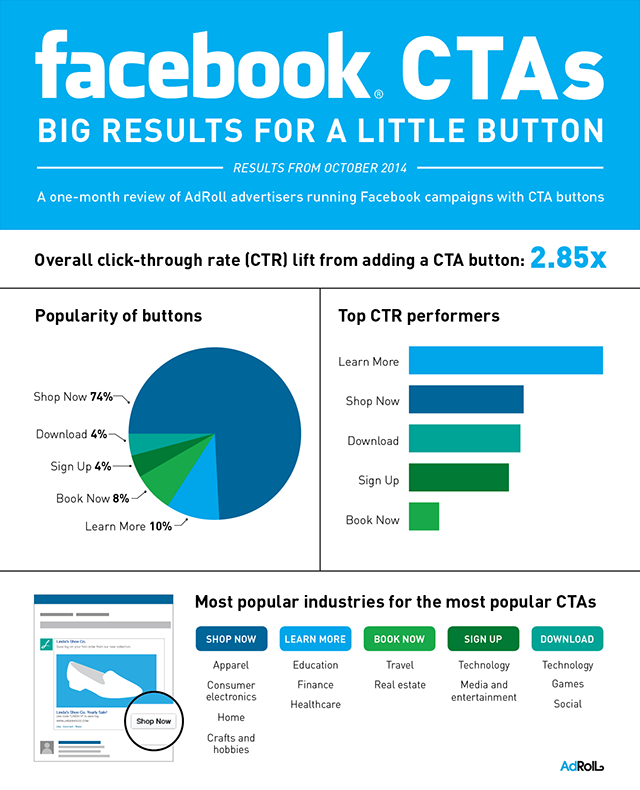
#16. A/B Testing
The path to high-performing Facebook Ads is paved with continuous optimization. A/B testing is your secret weapon for discovering winning ad elements and maximizing campaign effectiveness.
What is A/B Testing?
A/B testing pits two variations of an ad against each other to determine which one resonates better with your target audience. You can test various elements, including:
- Creatives: Compare different images, videos, or ad formats to see which captures attention most effectively.
- Copywriting: Test variations of headlines, body text, and calls to action to identify the messaging that drives higher engagement and conversions.
- Targeting: Experiment with different targeting parameters ( demographics, interests, etc.) to see which audience segments yield the best results.
How to conduct A/B tests effectively:
- Access Ads Manager: Navigate to the Ads Manager main table, where you can view all your ads, campaigns, and ad sets.
- Select Ads or Ad Sets: Choose the ads or ad sets you want to include in the A/B test by checking the corresponding boxes. You can also create a custom selection by duplicating a campaign or ad set and adjusting variables for the test.
- Initiate A/B Test: Click on the A/B Test option from the toolbar above the table.
- Choose Variables: Select the variable you want to test, such as different ad creatives, copy variations, or target audiences.
- Follow Instructions: Follow the on-screen instructions to set up the A/B test based on your selected variables.
- Analyze Results: Once the test is complete, analyze the results to determine which variations performed better. Ensure your hypothesis is clear and measurable to accurately evaluate the outcomes.
Final word
By following these steps and continuously monitoring your campaigns, you can ensure your Facebook Ads are reaching the right people and driving the results you desire. Remember, optimize Facebook Ads is an ongoing process, so be patient, experiment, and learn from your data.







